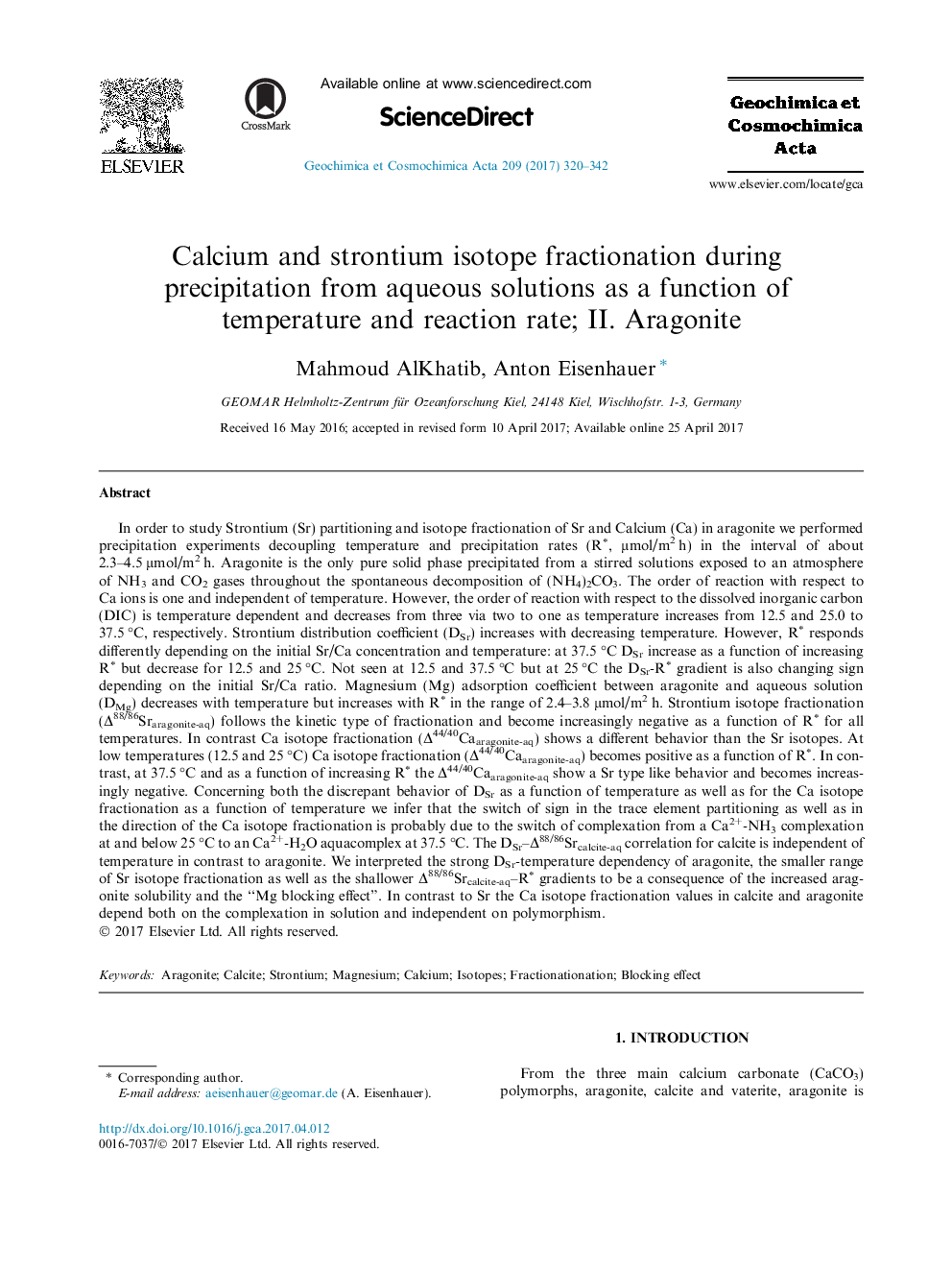| کد مقاله | کد نشریه | سال انتشار | مقاله انگلیسی | نسخه تمام متن |
|---|---|---|---|---|
| 5783292 | 1637948 | 2017 | 23 صفحه PDF | دانلود رایگان |
In order to study Strontium (Sr) partitioning and isotope fractionation of Sr and Calcium (Ca) in aragonite we performed precipitation experiments decoupling temperature and precipitation rates (Râ, μmol/m2 h) in the interval of about 2.3-4.5 μmol/m2 h. Aragonite is the only pure solid phase precipitated from a stirred solutions exposed to an atmosphere of NH3 and CO2 gases throughout the spontaneous decomposition of (NH4)2CO3. The order of reaction with respect to Ca ions is one and independent of temperature. However, the order of reaction with respect to the dissolved inorganic carbon (DIC) is temperature dependent and decreases from three via two to one as temperature increases from 12.5 and 25.0 to 37.5 °C, respectively. Strontium distribution coefficient (DSr) increases with decreasing temperature. However, Râ responds differently depending on the initial Sr/Ca concentration and temperature: at 37.5 °C DSr increase as a function of increasing Râ but decrease for 12.5 and 25 °C. Not seen at 12.5 and 37.5 °C but at 25 °C the DSr-Râ gradient is also changing sign depending on the initial Sr/Ca ratio. Magnesium (Mg) adsorption coefficient between aragonite and aqueous solution (DMg) decreases with temperature but increases with Râ in the range of 2.4-3.8 μmol/m2 h. Strontium isotope fractionation (Î88/86Sraragonite-aq) follows the kinetic type of fractionation and become increasingly negative as a function of Râ for all temperatures. In contrast Ca isotope fractionation (Î44/40Caaragonite-aq) shows a different behavior than the Sr isotopes. At low temperatures (12.5 and 25 °C) Ca isotope fractionation (Î44/40Caaragonite-aq) becomes positive as a function of Râ. In contrast, at 37.5 °C and as a function of increasing Râ the Î44/40Caaragonite-aq show a Sr type like behavior and becomes increasingly negative. Concerning both the discrepant behavior of DSr as a function of temperature as well as for the Ca isotope fractionation as a function of temperature we infer that the switch of sign in the trace element partitioning as well as in the direction of the Ca isotope fractionation is probably due to the switch of complexation from a Ca2+-NH3 complexation at and below 25 °C to an Ca2+-H2O aquacomplex at 37.5 °C. The DSr-Î88/86Srcalcite-aq correlation for calcite is independent of temperature in contrast to aragonite. We interpreted the strong DSr-temperature dependency of aragonite, the smaller range of Sr isotope fractionation as well as the shallower Î88/86Srcalcite-aq-Râ gradients to be a consequence of the increased aragonite solubility and the “Mg blocking effect”. In contrast to Sr the Ca isotope fractionation values in calcite and aragonite depend both on the complexation in solution and independent on polymorphism.
Journal: Geochimica et Cosmochimica Acta - Volume 209, 15 July 2017, Pages 320-342
